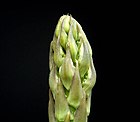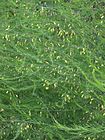Note: This is a project under development. The articles on this wiki are just being initiated and broadly incomplete. You can Help creating new pages.
Difference between revisions of "Asparagus officinalis"
(→Chemical Composition) |
|||
| Line 8: | Line 8: | ||
==Chemical Composition== | ==Chemical Composition== | ||
| − | + | Variations in the copper, iron, zinc, manganese, calcium, magnesium, sodium, potassium and phosphorous content of fresh white asparagus (Asparagus officinalis, L.) as a function of the spear portion and the differences between varieties (Desto and Cipre's) and thicknesses (<11 and >14mm) of asparagus were investigated.<ref name="chemical composition"/> | |
==Common names== | ==Common names== | ||
Latest revision as of 12:55, 30 March 2020
Asparagus officinalis is a herbaceous perennial plant. It is having arching stems growing up from large underground rhizomes. It can grow up to 120cm tall. The plant is often cultivated on a commercial scale for its young shoots which are eaten in many countries of the world. The plant also has a wide range of traditional medicinal uses.
Contents
[hide]- 1 Uses
- 2 Parts Used
- 3 Chemical Composition
- 4 Common names
- 5 Properties
- 6 Habit
- 7 Identification
- 8 List of Ayurvedic medicine in which the herb is used
- 9 Where to get the saplings
- 10 Mode of Propagation
- 11 How to plant/cultivate
- 12 Commonly seen growing in areas
- 13 Photo Gallery
- 14 References
- 15 External Links
Uses
Jaundice, Congestive torpor of the liver, Urinary problems, Cancer, Lower blood pressure, Schistosomiasis.
Parts Used
Chemical Composition
Variations in the copper, iron, zinc, manganese, calcium, magnesium, sodium, potassium and phosphorous content of fresh white asparagus (Asparagus officinalis, L.) as a function of the spear portion and the differences between varieties (Desto and Cipre's) and thicknesses (<11 and >14mm) of asparagus were investigated.[1]
Common names
| Language | Common name |
|---|---|
| Kannada | |
| Hindi | |
| Malayalam | |
| Tamil | |
| Telugu | |
| Marathi | |
| Gujarathi | |
| Punjabi | |
| Kashmiri | |
| Sanskrit | |
| English |
Properties
Reference: Dravya - Substance, Rasa - Taste, Guna - Qualities, Veerya - Potency, Vipaka - Post-digesion effect, Karma - Pharmacological activity, Prabhava - Therepeutics.
Dravya
Rasa
Guna
Veerya
Vipaka
Karma
Prabhava
Habit
Identification
Leaf
| Kind | Shape | Feature |
|---|---|---|
Flower
| Type | Size | Color and composition | Stamen | More information |
|---|---|---|---|---|
| {{{5}}} |
Fruit
| Type | Size | Mass | Appearance | Seeds | More information |
|---|---|---|---|---|---|
Other features
List of Ayurvedic medicine in which the herb is used
Where to get the saplings
Mode of Propagation
How to plant/cultivate
Asparagus officinalis is a plant of mainly low elevations in the temperate zone, though it can also be cultivated at higher elevations from 1,000 metres up to 2,600 metres in the Tropics.[3]
Commonly seen growing in areas
Photo Gallery
References
- Jump up ↑ Chemistry
- Jump up ↑ [Morphology]
- Jump up ↑ Cultivation
External Links
- Ayurvedic Herbs known to be helpful to treat Jaundice
- Ayurvedic Herbs known to be helpful to treat Congestive torpor of the liver
- Ayurvedic Herbs known to be helpful to treat Urinary problems
- Ayurvedic Herbs known to be helpful to treat Cancer
- Ayurvedic Herbs known to be helpful to treat Lower blood pressure
- Ayurvedic Herbs known to be helpful to treat Schistosomiasis
- Herbs with Roasted seeds used in medicine
- Herbs with Young shoots used in medicine
- Habit - Perennial
- Index of Plants which can be propagated by Seeds
- Herbs that are commonly seen in the region of Fertile soils
- Herbs that are commonly seen in the region of Sandy soils
- Herbs
- Pages without herbs images






